Related Research Articles

Danainae is a subfamily of the family Nymphalidae, the brush-footed butterflies. It includes the Daniadae, or milkweed butterflies, who lay their eggs on various milkweeds on which their larvae (caterpillars) feed, as well as the clearwing butterflies (Ithomiini), and the tellervini.

Dagon or Dagan is an ancient Mesopotamian and ancient Canaanite deity. He appears to have been worshipped as a fertility god in Ebla, Assyria, Ugarit, and among the Amorites.

The Nymphalidae are the largest family of butterflies, with more than 6,000 species distributed throughout most of the world. Belonging to the superfamily Papilionoidea, they are usually medium-sized to large butterflies. Most species have a reduced pair of forelegs and many hold their colourful wings flat when resting. They are also called brush-footed butterflies or four-footed butterflies, because they are known to stand on only four legs while the other two are curled up; in some species, these forelegs have a brush-like set of hairs, which gives this family its other common name. Many species are brightly coloured and include popular species such as the emperors, monarch butterfly, admirals, tortoiseshells, and fritillaries. However, the under wings are, in contrast, often dull and in some species look remarkably like dead leaves, or are much paler, producing a cryptic effect that helps the butterflies blend into their surroundings.

The Satyrinae, the satyrines or satyrids, commonly known as the browns, are a subfamily of the Nymphalidae. They were formerly considered a distinct family, Satyridae. This group contains nearly half of the known diversity of brush-footed butterflies. The true number of the Satyrinae species is estimated to exceed 2,400.

Hypolimnas bolina, the great eggfly, common eggfly or in New Zealand the blue moon butterfly is a species of nymphalid butterfly found from Madagascar to Asia and Australia.

Euploea sylvester, the double-branded crow, also known as the two-brand crow in Australia, is a butterfly found in South Asia, Southeast Asia and parts of Australia that belongs to the crows and tigers, that is, the danaid group of the brush-footed butterflies family.
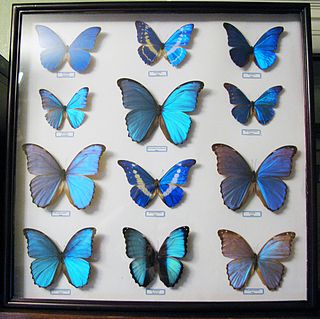
The Morphinae are a subfamily of Nymphalidae butterflies that includes the morphos, the owl butterflies (Caligo), and related lineages. It is either considered a sister group of the Satyrinae, or disassembled and included therein.
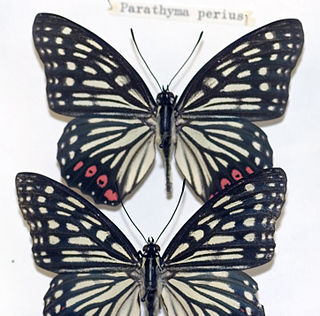
Hestina assimilis, the red ring skirt, is a species of butterfly in the family Nymphalidae found in Asia. It is generally of large size. There are several subspecies: H. a. assimilis, H. a. formosana (Moore, H. a. shirakii, and H. a. f. nigrivena

Agrias is a genus of Neotropical charaxine nymphalid butterflies found in South and Central America.
Butterfly evolution is the origin and diversification of butterflies through geologic time and over a large portion of the Earth's surface. The earliest known butterfly fossils are from the mid Eocene epoch, between 40-50 million years ago. Their development is closely linked to the evolution of flowering plants, since both adult butterflies and caterpillars feed on flowering plants. Of the 220,000 species of Lepidoptera, about 45,000 species are butterflies, which probably evolved from moths. Butterflies are found throughout the world, except in Antarctica, and are especially numerous in the tropics; they fall into eight different families.

The Haeterini are one of the smaller tribes of the Satyrinae in the Nymphalidae family. The tribe occurs exclusively in tropical rain forests in the Neotropical realm.

The butterfly subtribe Euptychiina is a diverse group within the tribe Satyrini, occurring throughout Central and South America, in addition to a few species known from North America. Euptychiina is a predominantly lowland group, with the exception of one Asian taxon Palaeonympha opalinaButler, 1871 and the Andean genus ForsterinariaGray, 1973. The taxon was erected by Lee Denmar Miller.

Junonia evarete, the Tropical Buckeye or West Indian buckeye, is a Neotropical butterfly of the Nymphalids (Nymphalidae) family. It has characteristic eye spots on the wings, which have a wingspan between 4.5 and 6.5 cm. This butterfly is easily confused with Junonia genoveva, the mangrove buckeye. Not only have the common names mangrove and tropical buckeye been confused, but the butterflies themselves have been sometimes misidentified in past literature, because the two species have many variations, subspecies and seasonal forms, which makes it difficult to identify or differentiate. Phylogenetic studies demonstrate the separation of evarete and genoveva, but evidence suggests that subspecies and perhaps additional species await their descriptions within this group.

The Libytheinae are a nymphalid subfamily known as snout butterflies, containing two valid genera and about ten species: six in Libythea and four in Libytheana. The common name refers to the thick labial palps (pedipalps) that look like a "snout" in this subfamily. In older literature, this group was recognized as the family Libytheidae. They are medium-sized and typically a drab brown. The front legs are reduced in length and the ventral hindwings are cryptically colored to help them blend in with their surroundings. While at rest, the members of this subfamily keep their wings tightly closed to resemble dead leaves.

Kallima, known as the oakleaf or oak leaf butterflies, is a genus of butterflies of the subfamily Nymphalinae in the family Nymphalidae. They are found in east, south and southeast Asia. Their common name is a reference to the lower surface of their wings, which is various shades of brown like a dead leaf.
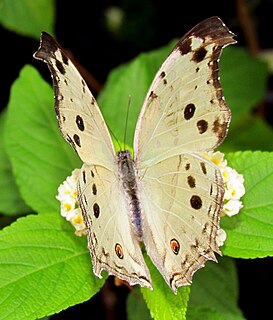
Protogoniomorpha parhassus, the forest mother-of-pearl or common mother-of-pearl, is a species of Nymphalidae butterfly found in forested areas of Africa.
Victor Gurney Logan Van Someren was a zoologist and entomologist.
Charaxes x fuscus is a naturally occurring hybrid between two sympatric species of butterfly in the family Nymphalidae. It was found in the Central African Republic. The habitat consists of lowland evergreen forests.
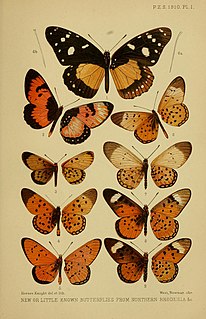
Acraea diogenes is a butterfly in the family Nymphalidae. It is found in the Democratic Republic of the Congo, Angola and north-western and north-eastern Zambia.
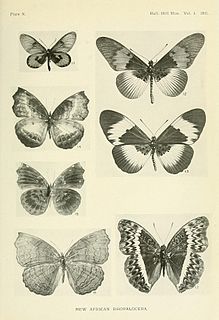
Ariadne albifascia, the white-banded castor, is a butterfly in the family Nymphalidae.The Biblidinae are a subfamily of butterflies with over 350 species worldwide, the vast majority of which are Neotropical. In the Afrotropical region there 30 species, in the genera Byblia, Ariadne, Eurytela, Neptidopsis, Sevenia and Mesoxantha. It is found in Sierra Leone, Liberia, Ivory Coast, Ghana, Nigeria, Cameroon, the Republic of the Congo, the Central African Republic, the Democratic Republic of the Congo and western Uganda. The habitat consists of forests, especially open degraded habitats.
References
- "Dagon Higgins, 1981" at Markku Savela's Lepidoptera and Some Other Life Forms (Archived by WebCite at https://www.webcitation.org/5ulKkEy5t?url=http://www.nic.funet.fi/pub/sci/bio/life/insecta/lepidoptera/ditrysia/papilionoidea/nymphalidae/nymphalinae/dagon/index.html
| | This Nymphalinae article is a stub. You can help Wikipedia by expanding it. |